Sushi Page
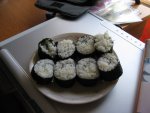
Not a fish person at all, sushi never interested me since I misunderstood that it was about fish. However, in recent years, I’ve taken to eating it with a passion and I have found a number of rolls I really crave. This is a very preliminary page about sushi.
I especially like rolls with avocado—what one book on sushi I have describes as the “tuna of the garden.” Avocados are one of the top proofs of a benevolent, loving Maker.
Above, at right, you see my very first roll, which was only an experiment to see a) if I could do the rice correctly and b) if I could execute the roll between kneadings of a bread dough I happened to be making one Sunday afternoon.
Rolling and cutting this plain rice roll was far easier than I thought it would be. I was following instructions from one of the books listed below. This roll is an example of chumaki-zushi. (Note: some of the rice kernels are browned because for the experiment, I used only one cup of rice and rice cookers are notorious for browning rice at the bottom even when you unplug them as soon as they’re done. As I wasn’t eating that day anyway, I threw the roll out a few hours after making it.)
A linguistic note...
When sushi is a component of a word, when it follows a vowel in that word, the initial s becomes voiced. On this page, you will see zushi written in many places for this reason.
What kinds of sushi?
| Maki-zushi | in Japan, just means "rolled," the collective style shown on this page | |
| Futomaki-zushi | Thick-roll sushi | |
| Chumaki-zushi | Medium-roll sushi | |
| Hosomaki-zushi | Thin-roll sushi | |
| Uramaki-zushi | Inside-out roll sushi | |
| Nigiri-zushi | Fish-topped rice sushi | |
| Temaki-zushi | Hand-wrapped or cone-shape sushi | |
| Inari-zushi | Pouch sushi | |
| Gunkan maki-zushi | Battleship rolls | |
| Chirasi-zushi | Sushi in a bowl | |
| Sashimi | Not sushi at all, but just pieces of fresh, raw meat or fish |
Preparing the rice...
It’s all about rice in sushi. If you don’t get the rice right, no other ingredient will save you.
Sushi rice is drier than rice used for other purposes. At this point, I’m buying made-for-sushi rice (instead of Jasmine which I loooooove) and making it in my rice cooker in a ratio of one part rice to one-and-one-fourth parts water.
Based on my first experiences at rolling, one cup of rice produces enough cooked rice to make one chumaki-zushi roll and one Hosomaki-zushi roll.
You will need the following supplies:
| — | chlorine to disinfect counter top | |||||||||
| — | rice | |||||||||
| — | tap water | |||||||||
| — | filtered water | |||||||||
| — | rice cooker (typically) | |||||||||
| — | desk fan | |||||||||
| — | wooden paddle, bench scraper or spatula | |||||||||
| — | seasoning solution:
|
Here’s how to make the rice.
- Wash rice with tap water; it does not have to run clear, but it must be rinsed 4-5 times.
- Measure rice into cooker.
- Measure 1¼ volume of water to rice volume.
- Launch cooker and wait.
- Remove rice immediately from cooker when button pops up; if you do not, it will brown against the bottom of the pot, especially if your cooker goes to warming mode automatically.
- Spread rice out on disinfected counter top.
- Turn fan onto rice going low speed.
- Pour a little seasoning liquid over the wooden paddle and sprinkle lightly over rice.
- Toss rice to get each grain “coated” with seasoning liquid. Add more seasoning liquid during this process.
- Once thoroughly processed and cool, gather rice into a bowl.
At this point, you’re ready to make sushi.
Tempura in sushi...
Tempura-battered and fried shrimp and vegetables hide a nice surprise in sushi that will inhibit your guests from ever labeling your sushi as bland and uninteresting. So awaken those tempura skills!
Vegetables in sushi
I love julienned vegetables of various sorts in my sushi. Try: cucumbers, avocado, carrots, scalions, asparagus, zucchini, etc.
Sushi Rolls
The avocado roll
I make an inside-out roll (the rice wraps the nori rather than the other way around and then slice an avocado half very thinly. Pressing down carefully on the avocado, I spread it out lengthwise as the slices slip against each other. I pick it up with a broad knife blade and lay it on the roll. Then I wrap it down around the roll to produce a caterpillar roll. See illustrations below.
The Vic roll
Vic is my son, a vegan and, after numerous times of ordering sushi at the Happy Sumo in Salt Lake City where he is a very famous tattoo artist, he got a completely vegan roll made and named for him and placed on file at all Happy Sumo restaurants. It’s a caterpillar roll with kampio, sweet and fried tofu julienned, tempura asparagus shoots and eel sauce.
The vegetarian firecracker
Another roll my son champions at the Happy Sumo is the vegetarian firecracker. (add ingredients list here)
Bibliography
I wholeheartedly recommend the following two books as a basic set in your library, the first one for beautiful illustrations (it’s a coffee table book that has very good content as well) and the second for technique.
Dekura, Treolar, Yoshii, The Complete Book of Sushi, 2004, Periplus Editions (HK) Ltd., North Clarendon, Vermont.
Strada, Takane-Moreno, Sushi for Dummies, 2004, Wiley Publishing, Indianapolis, Indiana.
Illustrations
Early Sushi rolls made at two parties with my daughter, Andrea, who decided independently to become a sushi chef at the same time and surprised me. (She is very much better than I.) We’ve also done tuna and salmon rolls which, if fresh, are’t fishy at all.
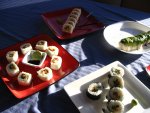
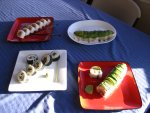
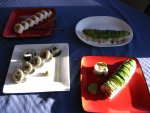
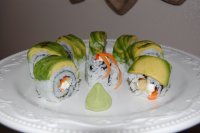
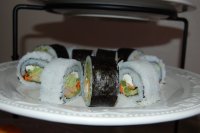
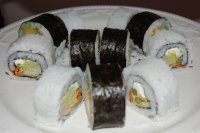
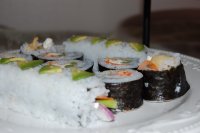
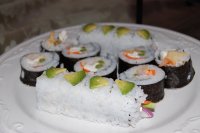
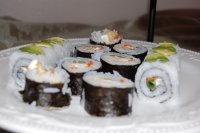
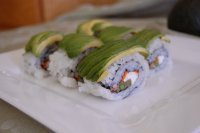
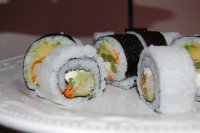
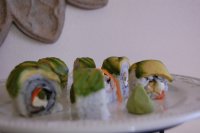
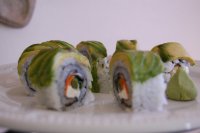

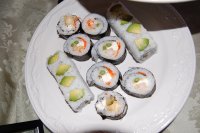
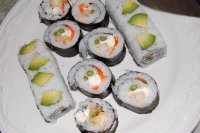
|